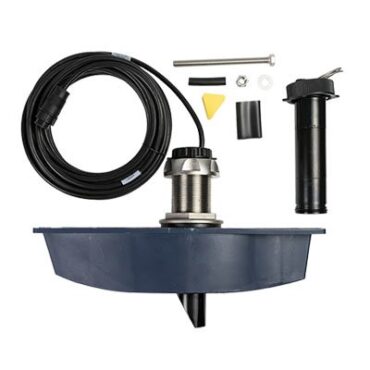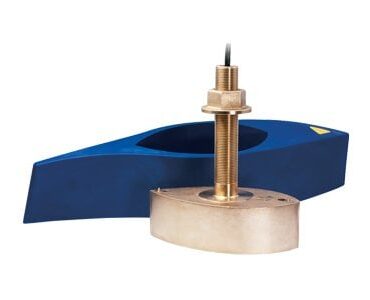Key Features
- 28-60 kHz Low CHIRP with 23-9° beam width
- 150-250 kHz High CHIRP with wide 25° beam for excellent fish targets
- Up to 2400 m (8000 ft) range with Low CHIRP
- 25 internal broadband ceramics
- Tank/Pocket/Keel-mounted with epoxy housing and recessed design (same shape and size as R599 and CM199)
- Suitable for fiberglass hulls only
- Ideal for sportfishing and commercial vessels 8 m (25 ft) and up
- Recommended for use with the BSM-3 broadband sounder module
Dual Channel CHIRP
Using pulsed transmissions swept across a range of frequencies, CHIRP technology delivers target resolution and depth penetration superior to traditional single-frequency sonar. This dual-channel CHIRP transducer operates in the 28-60 kHz Low CHIRP frequency range with a 23-9° beam width, and the 150-250 kHz High CHIRP frequency range with a 25° beam width. With Low CHIRP, the CM599LH-W provides an operating depth of up to 2400 m (8000 ft).
Wide Angle CHIRP
Ideal for anglers, the CM599LH-W’s wide-angle technology delivers a constant 25° beam width across the transducer’s 150-250 kHz High CHIRP frequency range. This achieves up to double the coverage beneath your boat, and provides enhanced fish detection in the upper water column, versus the narrower beam of other high-frequency CHIRP transducers.
Depth/Temperature
One sensor does it all. Able to measure both depth and temperature in a single package, the CM599LH-W simplifies installation and requires just one connection to your echosounder module or multifunction display.
Mounting
With epoxy housing, the CM599LH-W is suitable for tank, pocket or keel mounting in fiberglass hulls only.
Pocket- or keel-mounting installs the transducer flush to the hull in a custom pocket, providing minimal drag and good high-speed performance. Boat builders may incorporate this transducer in new hulls, and aftermarket installation is possible by routing a suitable hole and fiberglassing the transducer in place.
Tank-mounting places the transducer in a seawater-filled tank on the outside of the hull, with the active face and sides of the transducer exposed to seawater inside the tank. A hole must be drilled through the hull for the transducer cable to enter via a stem or stuffing tube.

 Ελληνικά
Ελληνικά












